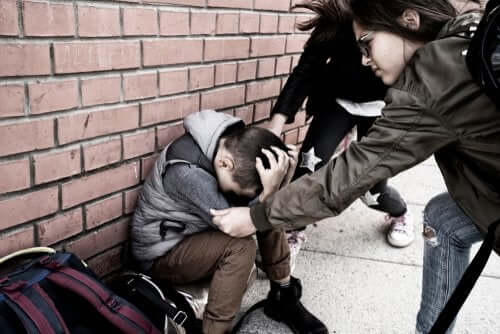How to Educate Children in Non-violence

Unfortunately, violence has been and continues to be very present in all human societies throughout history. However, as Edward James Olmos once said, education is the vaccine against violence. That said, keep reading and discover how to educate children in non-violence.
Educate in peace to educate in non-violence
The United Nations Children’s Fund (UNICEF) defines peace education as a process of promoting the knowledge, skills, attitudes and values needed to bring about behavioral changes that enable children, youth and adults to prevent conflict and violence, resolve conflicts peacefully, and create conditions conducive to peace.
For its part, the United Nations Educational, Scientific, and Cultural Organization (UNESCO) understands that in order to educate children in non-violence, training in democratic coexistence and educational inclusion is indispensable.
“Unless we teach children peace, someone else will teach them violence.”
– Colman McCarthy –

Educational inclusion and democratic coexistence as pillars of a culture of peace
With respect to educational inclusion, UNESCO values diversity as a pillar of peace culture. Having said that, how do we develop and structure inclusive education?
To begin with, inclusive education must aim at learning to live with what’s different. It’s a fact that our societies, and therefore our schools, have changed, and diversity is a reality in our daily lives.
In view of this, we must know how to manage this diversity. What’s more, we must educate new generations to respect diversity and appreciate its richness.
“Educating in equality and respect is educating against violence.”
– Benjamin Fanklin –
At the same time, we must learn to identify and eliminate the barriers that students at risk of social exclusion face. That way, we can seek their participation.
Elements must come into play when educating children in non-violence
With respect to democratic coexistence, the Research Institute for the Development of Education (INIDE) of the University of Mexico understands that, when educating for democratic coexistence, a series of elements must come into play:
- Participation. According to the INIDE, we must create conditions so that girls and boys know their rights. What’s more, they must be able to enjoy and exercise these rights in daily life.
- Citizenship. To favor children’s place in society as citizens. In other words, active subjects that not only know their rights, but also assume their obligations. And therefore being co-responsible in the construction of the common good to create a democratic society.
- Teamwork. INIDE understands teamwork as fundamental, defining it as the sum of efforts to achieve a common goal. In other words, it’s a capacity that implies drawing up common objectives in order to reach agreements and assume tasks oriented in the same direction, etc.
- Autonomy. This refers to the importance of teaching children to be self-directed by internalized norms. It means giving them sense and meaning. And, consequently, it helps them understand that these agreed-upon norms contribute to the regulation of social life.
Ideas for educating in non-violence
- Emotional education. That is, teaching children to know and understand their emotions is essential to help them know how to manage complex emotions such as anger. Role-playing and activities that help children learn to listen and respond to others are some examples that teach young people to solve problems without resorting to violence.
- Educate in dialogue. Educating children in non-violence requires teaching them conflict resolution skills. In other words, teach them that dialogue, mediation, and negotiation are the only weapons that lead to peace.
- Fostering trust. Showing the importance of mutual trust makes it easier to keep the lines of communication open And this is essential in preventing violence.
In conclusion, we must know how to educate and lead young people towards a culture of peace and non-violence through strategies of conflict resolution, emotion management, autonomy, and participation. At the same time, we must teach them the value of a society free of violence and conflict.
Unfortunately, violence has been and continues to be very present in all human societies throughout history. However, as Edward James Olmos once said, education is the vaccine against violence. That said, keep reading and discover how to educate children in non-violence.
Educate in peace to educate in non-violence
The United Nations Children’s Fund (UNICEF) defines peace education as a process of promoting the knowledge, skills, attitudes and values needed to bring about behavioral changes that enable children, youth and adults to prevent conflict and violence, resolve conflicts peacefully, and create conditions conducive to peace.
For its part, the United Nations Educational, Scientific, and Cultural Organization (UNESCO) understands that in order to educate children in non-violence, training in democratic coexistence and educational inclusion is indispensable.
“Unless we teach children peace, someone else will teach them violence.”
– Colman McCarthy –

Educational inclusion and democratic coexistence as pillars of a culture of peace
With respect to educational inclusion, UNESCO values diversity as a pillar of peace culture. Having said that, how do we develop and structure inclusive education?
To begin with, inclusive education must aim at learning to live with what’s different. It’s a fact that our societies, and therefore our schools, have changed, and diversity is a reality in our daily lives.
In view of this, we must know how to manage this diversity. What’s more, we must educate new generations to respect diversity and appreciate its richness.
“Educating in equality and respect is educating against violence.”
– Benjamin Fanklin –
At the same time, we must learn to identify and eliminate the barriers that students at risk of social exclusion face. That way, we can seek their participation.
Elements must come into play when educating children in non-violence
With respect to democratic coexistence, the Research Institute for the Development of Education (INIDE) of the University of Mexico understands that, when educating for democratic coexistence, a series of elements must come into play:
- Participation. According to the INIDE, we must create conditions so that girls and boys know their rights. What’s more, they must be able to enjoy and exercise these rights in daily life.
- Citizenship. To favor children’s place in society as citizens. In other words, active subjects that not only know their rights, but also assume their obligations. And therefore being co-responsible in the construction of the common good to create a democratic society.
- Teamwork. INIDE understands teamwork as fundamental, defining it as the sum of efforts to achieve a common goal. In other words, it’s a capacity that implies drawing up common objectives in order to reach agreements and assume tasks oriented in the same direction, etc.
- Autonomy. This refers to the importance of teaching children to be self-directed by internalized norms. It means giving them sense and meaning. And, consequently, it helps them understand that these agreed-upon norms contribute to the regulation of social life.
Ideas for educating in non-violence
- Emotional education. That is, teaching children to know and understand their emotions is essential to help them know how to manage complex emotions such as anger. Role-playing and activities that help children learn to listen and respond to others are some examples that teach young people to solve problems without resorting to violence.
- Educate in dialogue. Educating children in non-violence requires teaching them conflict resolution skills. In other words, teach them that dialogue, mediation, and negotiation are the only weapons that lead to peace.
- Fostering trust. Showing the importance of mutual trust makes it easier to keep the lines of communication open And this is essential in preventing violence.
In conclusion, we must know how to educate and lead young people towards a culture of peace and non-violence through strategies of conflict resolution, emotion management, autonomy, and participation. At the same time, we must teach them the value of a society free of violence and conflict.
All cited sources were thoroughly reviewed by our team to ensure their quality, reliability, currency, and validity. The bibliography of this article was considered reliable and of academic or scientific accuracy.
- Unesco. (2008). Convivencia Democrática, inclusión y cultura de paz. Salesianos. Santiago: Chile.
- Unicef. Educación para la paz. Recuperado de: https://www.unicef.org/spanish/education/focus_peace_education.html
This text is provided for informational purposes only and does not replace consultation with a professional. If in doubt, consult your specialist.








